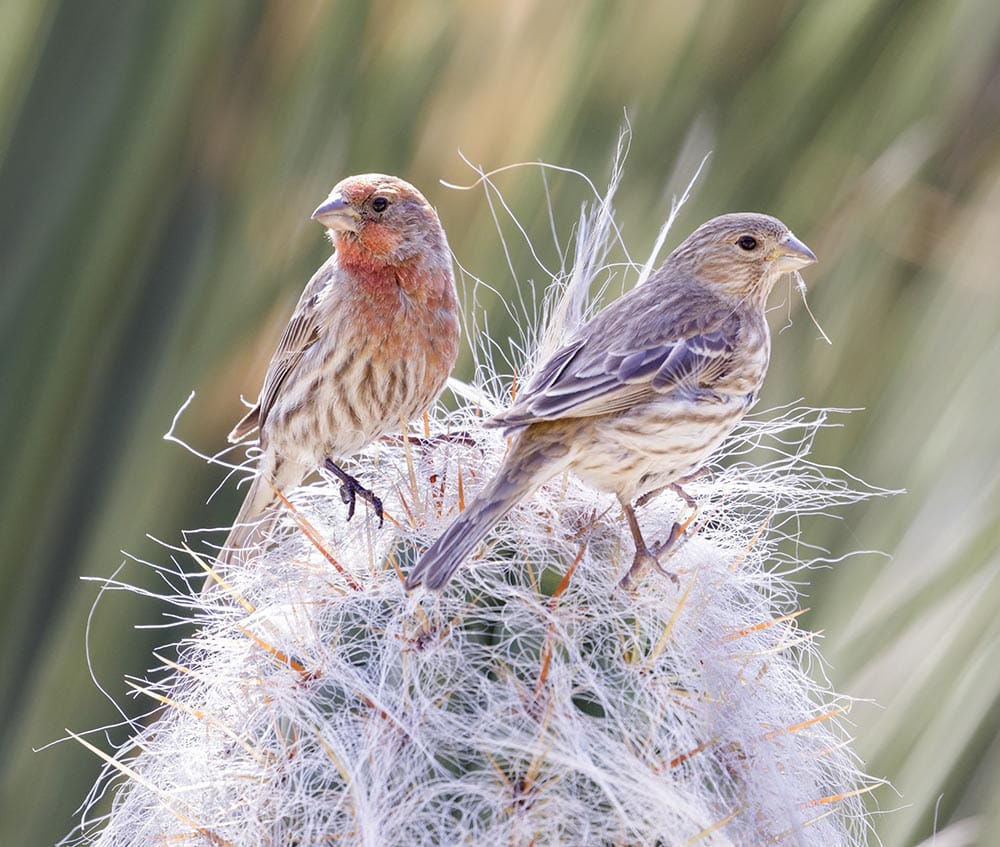House Finch Nesting Habits – Everything You Need to Know!
Last Updated on

The House Finch is a striking bird with its beautiful plumage. The male’s colors can range from yellow to orange to red, depending on its diet during molting. Of course, its purpose is to attract a female. These birds originally lived in western North America down into Mexico. That explains its genus name, mexicanus. Twelve subspecies exist, primarily in this country.1
The House Finch’s story is an interesting one and may explain some of its nesting habits. During the 1940s, unscrupulous sellers sold the birds in New York City, calling them Hollywood Finches.2 When authorities discovered these illegal activities, they released them. The rest, as they say, is history. House Finches now live across the United States into Canada.

Natural History
This early contact with humans and eventual spread influenced the behavior of House Finches and made them quite friendly. They are tolerant of people and adapt quickly to their surroundings. While they exist in the wilderness, you’re more likely to find them in your backyard at a feeder or park. They are year-round residents in most of the country, gathering in large flocks during the winter.
The International Union for Conservation of Nature and Natural Resources (IUCN) classifies the House Finch as a species of least concern, with an estimated population of 21 million birds. Its numbers have increased in recent years, perhaps because of its generalist diet and tolerance of humans. Unlike other introduced species like European Starlings, many people welcome these finches to their yards.

Courtship and Pair Bonding
House Finches have courtship rituals like many other avian species. They cement the bond between the birds with the shared responsibilities of their parental investment. They are monogamous and will pair up during the winter. The males perform an elaborate ritual called the butterfly flight. They will fly nearly 100 feet into the air and slowly flutter down to a perch, singing their melodious courtship song.
Females tend to prefer males with colorful plumage. Since its hue depends on what the male eats, it might be an indication of fitness that leads females to make these choices for prospective mates. Once they’ve bonded, the male will guard the female. He may also feed her, particularly if she acts like a fledgling begging to be fed. House Finches readily take nyjer and sunflower seeds.
Nest Building
Mating occurs in early spring. Birds often have specific roles in parenting. The House Finch is no exception. The female’s job is to build the nest. The female will make a small, cuplike nest composed of leaves, grass, twigs, and even feathers in a bush, small tree, tree cavity, or even in an opening in a building.

Eggs and Incubation
The female will lay between two to six eggs. They are typically blue with black and lavender spots, mainly near the large end. Only the female will incubate the eggs, although the male will feed her during this time. The young will hatch in about 14 days. The chicks are altricial, meaning they are completely helpless and dependent on their parents. The little ones resemble the female’s drab, streaked coloration.
House Finches may have up to six clutches of eggs a year. However, not all the young will survive or fledge. However, this number probably is a significant factor with the increasing population.
Fledgling Care
The female takes care of the young initially before the male shares the responsibility of feeding the nestlings. Eventually, he’ll take over the task entirely while the female starts the nesting process all over again. The young grow rapidly, fledging at about 12–19 days. The male may continue to care for the chicks until they are entirely independent.
House Finches are relatively long-lived for a species of its size. The longevity record for this bird based on banding data from the US Geological Survey is 11 years and 7 months. Interestingly, the top three were from the East Coast, where the finches were initially released.

Final Thoughts
House Finches are attractive birds that make welcome visitors to a bird feeder. Their beautiful colors and good parenting skills make them enjoyable to watch. Even though they are an introduced species, these birds have captured our hearts. They’re sure to brighten your day with their lovely songs. If you’re lucky, you may even be able to see them taking care of their young.
Featured Image Credit: yhelfman, Shutterstock
About the Author Chris Dinesen Rogers
Chris has been writing since 2009 on a variety of topics. Her motto with all of her writing is “science-based writing nurtured by education and critical thinking.” Chris specializes in science topics and has a special love for health and environmental topics, and animals of all shapes and sizes.
Related Articles:
10 Types of Hummingbirds in Arkansas (With Pictures)
8 Types of Hummingbirds in Nebraska (With Pictures)
5 Types of Hummingbirds in Idaho (With Pictures)
3 Types of Hummingbirds in Mississippi (With Pictures)
8 Types of Hummingbirds in Kansas (With Pictures)
5 Types of Hummingbirds in West Virginia (With Pictures)
5 Types of Hummingbirds in Ohio (With Pictures)
Where Do Nuthatches Nest? Nuthatch Nesting Habits Explained
